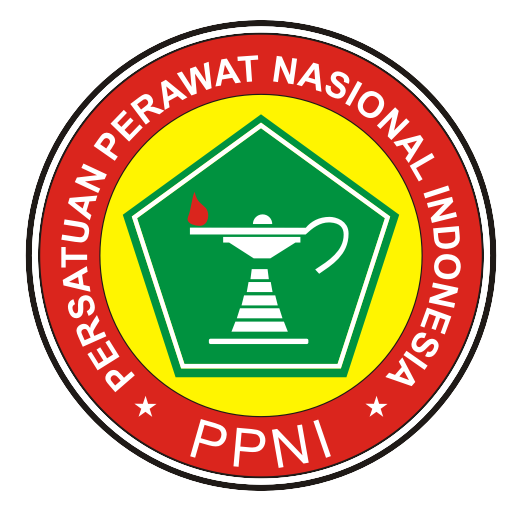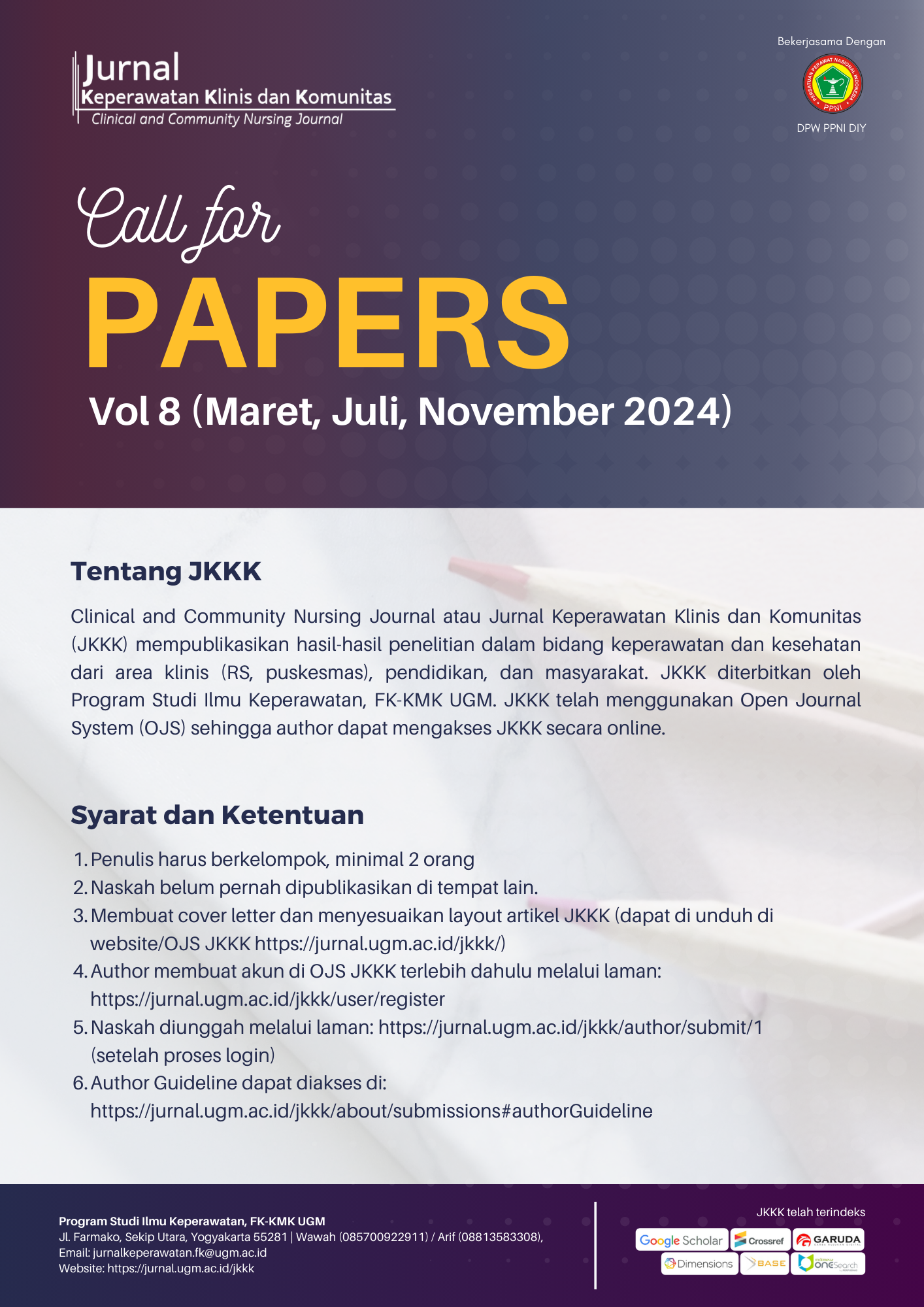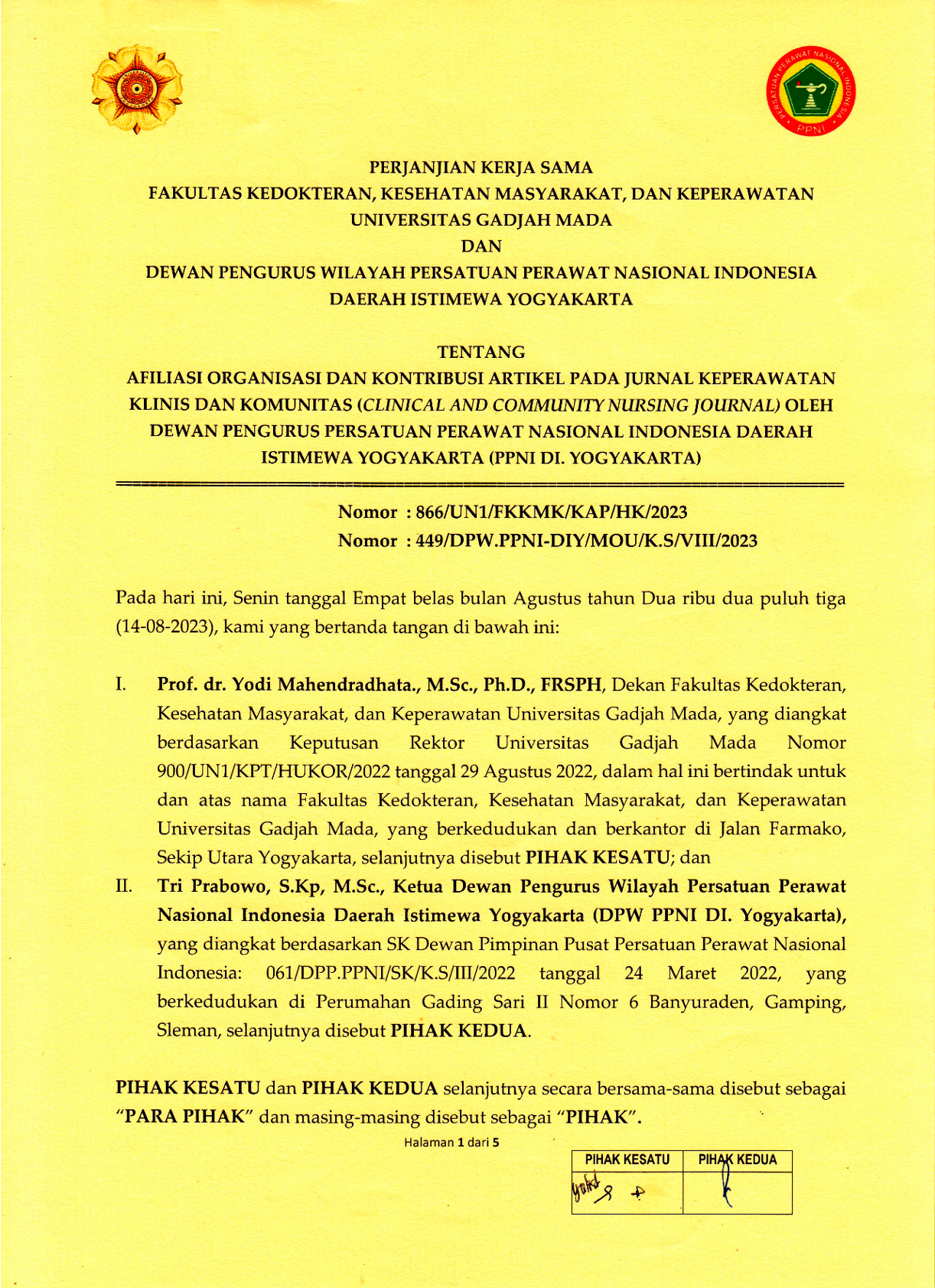Gambaran Persepsi dan Pengetahuan Kebersihan Tangan pada Pengunjung Intensive Care Unit Rumah Sakit Akademik Universitas Gadjah Mada Yogyakarta
Sulistina Alifah Purbaningrum(1), Sri Setiyarini(2), Happy Indah Kusumawati(3*), Eri Yanuar Akhmad Budi Sunaryo(4)
(1) Program Studi Ilmu Keperawatan, Fakultas Kedokteran, Kesehatan Masyarakat, dan Keperawatan, Universitas Gadjah Mada, Yogyakarta
(2) Departemen Keperawatan Dasar dan Emergensi, Program Studi Ilmu Keperawatan, Fakultas Kedokteran, Kesehatan Masyarakat, dan Keperawatan, Universitas Gadjah Mada, Yogyakarta
(3) Departemen Keperawatan Dasar dan Emergensi, Program Studi Ilmu Keperawatan, Fakultas Kedokteran, Kesehatan Masyarakat, dan Keperawatan, Universitas Gadjah Mada, Yogyakarta
(4) Rumah Sakit Akademik Universitas Gadjah Mada, Yogyakarta
(*) Corresponding Author
Abstract
Background: Intensive Care Unit (ICU) patients are immunosuppressive and susceptible to infection. Their visit toward ICU may increase pathogen contamination and infection transmission probability. One of the procedures to prevent infection transmission is hand hygiene. On the other hand, perception and knowledge among ICU visitors related to hand hygiene is still under-researched.
Objective: Describing the hand hygiene perception and knowledge of ICU visitors at Gadjah Mada University (UGM) Academic Hospital Yogyakarta.
Methods: This research was a descriptive study using survey. Participants were 100 visitors at the UGM Academic Hospital who visited ICU on December 2019. Data were collected by using a questionnaire of visitors' perception and knowledge of hand hygiene that refers to World Health Organisation 2009 guidance. Univariate analysis was utilized to analyze the data.
Results: Most of ICU visitors had good perception (61%) and good knowledge (53%). The best domain category for visitors’ perception was toward the availability of hand hygiene facilities and for visitors’ knowledge domain was toward hand hygiene media.
Conclusion: Most of the ICU visitors at UGM Academic Hospital has a good perception and knowledge related to hand hygiene.
ABSTRAK
Latar belakang: Pasien di Intensive Care Unit (ICU) memiliki kondisi yang imunosupresif sehingga rentan terhadap infeksi. Kunjungan ke ICU meningkatkan kontaminasi patogen dan berpotensi menularkan infeksi. Salah satu langkah untuk mencegah terjadinya penularan infeksi adalah hand hygiene. Aspek yang dapat memengaruhi hand hygiene adalah persepsi dan pengetahuan tentang hand hygiene. Di sisi lain, penelitian terkait hand hygiene oleh pengunjung di ICU masih jarang dilakukan.
Tujuan: Mengetahui gambaran persepsi dan pengetahuan hand hygiene pengunjung ICU RSA UGM Yogyakarta.
Metode: Penelitian ini adalah jenis penelitian deskriptif dengan rancangan penelitian survei. Responden dalam penelitian ini adalah pengunjung ICU RSA UGM Yogyakarta yang berjumlah 100 orang. Metode pengambilan data menggunakan kuesioner pengetahuan dan persepsi hand hygiene pengunjung yang mengacu pada panduan WHO tahun 2009. Pengambilan data dilakukan selama bulan Desember 2019. Analisis yang digunakan pada penelitian ini adalah analisis univariat.
Hasil: Mayoritas pengunjung memiliki persepsi yang baik (61%) dan pengetahuan yang baik (53%). Pengunjung memiliki persepsi yang baik pada domain ketersediaan fasilitas hand hygiene. Mayoritas pengunjung memiliki pengetahuan yang baik pada domain media hand hygiene.
Kesimpulan: Sebagian besar pengunjung ICU RSA UGM Yogyakarta mempunyai persepsi dan pengetahuan hand hygiene dengan kategori baik.
Keywords
Full Text:
PDFReferences
- Vincent J-L, Singer M, Marini JJ, Moreno R, Levy M, Matthay MA, et al. Thirty Years of Critical Care Medicine. Crit Care. 2010; 14(3): 311.
- Strich JR, Palmore TN. Preventing Transmission of Multidrug-Resistant Pathogens in The Intensive Care Unit. Infectious Disease Clinics of North America. 2017 Sep; 31(3): 535–50.
- Salawati L. Pengendalian Infeksi Nosokomial di Ruang Intensive Care Unit Rumah Sakit. Jurnal Kedokteran Syiah Kuala. 2012; 12.
- Hobbs MA, Robinson S, Neyens DM, Steed C. Visitor Characteristics and Alcohol-based Hand Sanitizer Dispenser Locations at The Hospital Entrance: Effect on Visitor Use Rates. American Journal of Infection Control. 2016 Mar; 44(3): 258–62.
- Malacarne P, Corini M, Petri D. Health Care-Associated Infections and Visiting Policy in An Intensive Care Unit. American Journal of Infection Control. 2011 Dec; 39(10): 898–900.
- Munoz-Price LS, Banach DB, Bearman G, Gould JM, Leekha S, Morgan DJ, et al. Isolation Precautions for Visitors. Infect Control Hosp Epidemiol. 2015 Jul; 36(7): 747–58.
- Birnbach DJ, Nevo I, Barnes S, Fitzpatrick M, Rosen LF, Everett-Thomas R, et al. Do Hospital Visitors Wash Their Hands? Assessing The Use of Alcohol-based Hand Sanitizer in A Hospital Lobby. American Journal of Infection Control. 2012 May; 40(4): 340–3.
- Fauzia SS, Handiyani H. Tingkat Pengetahuan dan Perilaku Kebersihan Tangan pada Pengunjung Rumah Sakit. 2014; 9.
- Ekarini P. Analisis Faktor yang Berhubungan dengan Perilaku Cuci Tangan Pengunjung Pasien Ruang Anak RSUD Dr. Sayidiman Magetan. Program Studi Magister Keperawatan Fakultas Kedokteran Universitas Gadjah Mada Yogyakarta. 2017.
- World Health Organization, Editor. WHO Guidelines on Hand Hygiene in Health Care: First Global Patient Safety Challenge: Clean Care is Safer Care. Geneva, Switzerland: World Health Organization, Patient Safety; 2009. 262 p.
- Putri AF. Pentingnya Orang Dewasa Awal Menyelesaikan Tugas Perkembangannya. SCHOULID Journal [Internet]. 2018 Jun 21 [cited 2020 Jun 20];3(2). Available from: https://jurnal.iicet.org/index.php/schoulid/article/view/430
- Simamora RH. Pengaruh Penyuluhan Identifikasi dengan Menggunakan Media Audiovisual terhadap Pengetahuan Pasien Rawat Inap. JKS. 2019 Nov 8; 3(1): 342–51.
- Kontribusi Pendidikan dalam Meningkatkan Kualitas Bangsa Indonesia. 2004; (4): 15.
- Styani E. Persepsi Keluarga tentang Waktu Berkunjung di Intensive Care Unit (ICU). 2017.
- Topçu S, Alpar ŞE. Patient Experiences in Intensive Care Units: A Systematic Review. Patient Experience Journal. 2017; 4(3): 14.
- El Marjiya Villarreal S, Khan S, Oduwole M, Sutanto E, Vleck K, Katz M, et al. Can Educational Speech Intervention Improve Visitors’ Hand Hygiene Compliance? Journal of Hospital Infection. 2020 Apr; 104(4): 414–8.
- Ta’adi, Setiyorini E, Amalya MR. Faktor yang Berhubungan dengan Kepatuhan Cuci Tangan 6 Langkah Momen Pertama pada Keluarga Pasien di Ruang Anak. 2019: 8.
- Notoatmodjo S. Ilmu Perilaku Kesehatan. Jakarta: Rineka Cipta; 2010.
- Hendayana R. Modul Persepsi dan Adopsi Teknologi. Bogor: Balai Besar Pengkajian dan Pengembangan Teknologi Pertanian; 2014.
- Foà C, Tura GA, Camelli C, Silingardi R, Kuenzer E, Carraro G, et al. Hand Hygiene in Healthcare Settings: The Citizens’ Point of View. Acta Biomed for Health Professions. 2017; 88: 40–53.
- Robbins SP, Judge TA. Essentials of Organizational Behavior. 14th Edition. Pearson; 2018. 95–100 p.
- Ciofi degli Atti ML, Tozzi AE, Ciliento G, Pomponi M, Rinaldi S, Raponi M. Healthcare Workers’ and Parents’ Perceptions of Measures for Improving Adherence to Hand-Hygiene. BMC Public Health. 2011 Dec; 11(1): 466.
- Pender N. The Health Promotion Model. University of Michigan. 2011; 19.
- Taplitz RA, Ritter ML, Torriani FJ. Infection Prevention and Control, and Antimicrobial Stewardship. In: Infectious Diseases [Internet]. Elsevier; 2017 [cited 2019 Jun 13]. p. 54-61.e1. Available from: https://linkinghub.elsevier.com/retrieve/pii/B978070206285800006X
- Aarestrup SC, Moesgaard F. Nudging Hospital Visitors’ Hand Hygiene Compliance. 2017 [cited 2020 Jun 20]; Available from: http://rgdoi.net/10.13140/RG.2.2.25911.52641
- Hess C, Ostrom E. Understanding Knowledge as A Commons: From Theory to Practice. London: The MIT Press; 2007.
- Ratnawati L, Sianturi SR. Faktor – Faktor yang Berhubungan dengan Kepatuhan Perawat dalam Menerapkan Hand Hygiene. Jurnal Ilmu Keperawatan dan Kebidanan. 2018 Jul 23; 9(2): 148.
- Cohen B, Hyman S, Rosenberg L, Larson E. Frequency of Patient Contact with Healthcare Personnel and Visitors: Implications for Infection Prevention. The Joint Commission Journal on Quality and Patient Safety. 2012 Dec; 38(12): 560–5.
- Fajriyah NN. Pengetahuan Mencuci Tangan Penunggu Pasien Menggunakan Lotion Antiseptic. The 2nd University Research Coloquium. 2015; 6.
- Hagel S, Ludewig K, Pletz MW, Frosinski J, Moeser A, Wolkewitz M, et al. Effectiveness of A Hospital-Wide Infection Control Programme on The Incidence of Healthcare-Associated Infections and Associated Severe Sepsis and Septic Shock: A Prospective Interventional Study. Clinical Microbiology and Infection. 2019 Apr; 25(4): 462–8.
- Satiti A, Frisca S, Nurjanah V. Hubungan Edukasi Cuci Tangan terhadap Pengetahuan, Sikap, dan Kemampuan Keluarga di Rumah Sakit X Palembang. 2019; 2: 10.
- Van der Vegt DSJM, Voss A. Are Hospitals Too Clean to Trigger Good Hand Hygiene? Journal of Hospital Infection. 2009 Jul; 72(3): 218–20.
- Banach DB, Bearman GM, Morgan DJ, Munoz-Price LS. Infection Control Precautions for Visitors to Healthcare Facilities. Expert Review of Anti-infective Therapy. 2015 Sep 2; 13(9): 1047–50.
Article Metrics
Refbacks
- There are currently no refbacks.
Copyright (c) 2021 Sulistina Alifah Purbaningrum, Sri Setiyarini, Happy Indah Kusumawati, Eri Yanuar Akhmad Budi Sunaryo

Jurnal Keperawatan Klinis dan Komunitas (Clinical and Community Nursing Journal)
collaborates with DPW PPNI DIY
![]()
Jurnal Keperawatan Klinis dan Komunitas (Clinical and Community Nursing Journal) is licensed under a Creative Commons Attribution-ShareAlike 4.0 International License.




